The iPhone 5 Review
by Anand Lal Shimpi, Brian Klug & Vivek Gowri on October 16, 2012 11:33 AM EST- Posted in
- Smartphones
- Apple
- Mobile
- iPhone 5
Apple's First LTE iPhone
Section by Brian Klug
If a third of the iPhone 5 story is the A6 SoC, and the other third is the change in display and industrial design, the final third is undoubtably cellular connectivity, specifically 4G LTE (Long Term Evolution). The iPad 3 was Apple’s first LTE-enabled consumer electronic, and the iPhone 5 is now Apple’s first LTE-enabled smartphone. The road to LTE for Apple’s iPhone is a long and interesting one, and unsurprisingly Apple waited for a second generation of LTE-enabled, 28nm basebands before making the move to LTE.
If you’ve already read our piece on the iPhone 5 SVLTE and SVDO situation a lot of this will already be familiar, as I pretty much gave all the background for what I wanted to talk about regarding the iPhone 5 and LTE in that piece at a high level.

MDM9615 and RTR8600 in iPhone 5 - Courtesy iFixit
At the core of the iPhone 5’s cellular architecture is Qualcomm’s MDM9615, which we’ve been predicting would be the solution Apple would use for some time now. This is a 28nm 2nd generation LTE baseband that has at its core the same modem IP block as what’s in MSM8960 and has already shipped in a bunch of phones. MDM9615 supports a host of air interfaces: Category 3 LTE FDD/TDD (Frequency and Time Division Duplexing), 3GPP Release 8 DC-HSPA+ (42.2 Mbps HSDPA/5.76 Mbps HSUPA), TD-SCDMA (4.2/2.2 Mbps), GSM/GPRS/EDGE, 1x-Advanced, and EVDO Rev.A and B. Of course, it depends on the individual OEM to implement the appropriate RF path for these features, but that’s at the maximum what MDM9615 supports.
| Apple iPhone - Cellular Trends | ||||||
| Release Year | Industrial Design | Cellular Baseband | Cellular Antennas | |||
| iPhone | 2007 | 1st gen | Infineon S-Gold 2 | 1 | ||
| iPhone 3G | 2008 | 2nd gen | Infineon X-Gold 608 | 1 | ||
| iPhone 3GS | 2009 | 2nd gen | Infineon X-Gold 608 | 1 | ||
| iPhone 4 (GSM/WCDMA) | 2010 | 3rd gen | Infineon X-Gold 618 | 1 | ||
| iPhone 4 (CDMA) | 2011 | 3rd gen | Qualcomm MDM6600 |
2 (Rx diversity, No Tx diversity) |
||
| iPhone 4S | 2011 | 3rd gen | Qualcomm MDM6610 (MDM6600 w/ ext. trans) |
2 (Rx/Tx diversity) |
||
| iPhone 5 | 2012 | 4th gen | Qualcomm MDM9615 w/RTR8600 ext. trans |
2 (Rx/Tx diversity, 2x1MIMO for LTE) |
||
In addition, MDM9615 is the first of Qualcomm’s LTE basebands to be natively voice enabled. MDM9600/9200 was originally designed as a data card solution primarily, but could work with voice if paired with a Qualcomm SoC in a so-called “Fusion” scenario. This was the major design caveat which made MDM9x00 an unlikely choice for anything but a smartphone platform based around a Qualcomm SoC but why it was suited to a platform that doesn’t need voice like the iPad 3. With MDM9x15 these barriers have come down, and along with it we get a smaller overall package size (from 13x13 mm down to 10x10 mm) and lower power consumption thanks to the move from 45nm TSMC to 28nm TSMC. The reality is that to implement cellular connectivity with any baseband you also need a PMIC (power management IC) and transceiver for downconversion after filters to I/Q data that gets shot into the appropriate port on the baseband itself. In this case the PMIC that works with MDM9x15 is PM8018 and the transceiver is either the 65nm RTR8600 in the case of the iPhone 5, or the 28nm WTR1605 that is just now emerging in some other phones. More on that last part in a minute.
| Apple iPhone 5 Models | ||||||
| iPhone 5 Model | GSM/EDGE Bands | WCDMA Bands | CDMA 1x/EVDO Rev.A/B Bands | LTE Bands (FCC+Apple) | ||
| A1428 "GSM" | 850/900/1800/1900 MHz | 850/900/1900/2100 MHz | N/A | 2/4/5/17 | ||
| A1429 "CDMA" | 850/900/1800/1900 MHz | 850/900/1900/2100 MHz | 800/1900/2100 MHz | 1/3/5/13/25 | ||
| A1429 "GSM" | 850/900/1800/1900 MHz | 850/900/1900/2100 MHz | NA | 1/3/5 (13/25 unused) | ||
Apple has already announced two hardware models for the iPhone 5: A1428 and A1429, of which one has two different provisioning configurations (A1429 comes in both a “CDMA” and “GSM” flavor). There are physical hardware differences between the two handsets, specifically differences in both the LTE power amplifiers and switches. The two hardware variants support different LTE bands, but the same set of WCDMA and GSM/EDGE bands. All three configurations of iPhone 5 support WCDMA with HSDPA Cat. 24 (DC-HSPA+ with 64QAM for up to 42 Mbps on the downlink) and HSUPA Cat. 6 (5.76 Mbps up). Only the A1429 “CDMA” configuration supports CDMA2000 1x and EVDO, and interestingly enough even supports EVDO Rev.B which includes carrier aggregation, though no carrier in the USA will ever run it. In addition the FCC reports include 1xAdvanced testing and certification for CDMA Band Classes 0 (800 MHz), 1 (1900 MHz), and 10 (Secondary 800 MHz).
| Apple iPhone LTE Band Coverage | |||||
| E-UTRA (LTE) Band Number | Applicable iPhone Model | Commonly Known Frequency (MHz) | Bandwidths Supported | ||
| 1 | A1429 | 2100 | 20, 15, 10, 5 MHz (?) | ||
| 2 | A1428 | 1900 | 20, 15, 10, 5, 3, 1.4 MHz | ||
| 3 | A1429 | 1800 | 20, 15, 10, 5, 3, 1.4 MHz(?) | ||
| 4 | A1428 | 1700/2100 | 20, 15, 10, 5, 3, 1.4 MHz | ||
| 5 | A1428, A1429 | 850 | 10, 5, 3, 1.4 | ||
| 13 | A1429 | 700 Upper C | 10, 5 | ||
| 17 | A1428 | 700 Lower B/C | 10, 5 | ||
| 25 | A1429 | 1900 | 20, 15, 10, 5, 3, 1.4 | ||
The difference in LTE bands is a bit more complicated, and both models appear to support more LTE bands than laid out if you simply inspect the iPhone 5 specs page. If we turn to the FCC documentation (which is concerned only with transmitters on regulated bands in the USA) we can glean that there are indeed more LTE bands supported. What’s interesting about this is that Apple did the same thing with the iPad 3 as well, supported a number of LTE bands above and beyond what was simply given on the spec page. I’m willing to bet that’s both a function of Apple wanting to cover as many possible configurations with as few hardware models as possible, and partly because with the right set of filters and PAs it’s entirely possible thanks to the fact that Qualcomm’s transceivers have ports that are created equal. That doesn’t explain why we don’t have WCDMA on AWS on A1428 considering LTE support for band 4, but I’ll admit I don’t know every exacting detail there. Anyhow, I’m presenting the two tables I made for the previous piece with what bands each model covers.
It was touched on in the keynote, but the iPhone 5 likewise inherits the two-antenna cellular design that was touted from the 4S. This is the original mitigation for iPhone 4 “deathgrip” which was introduced somewhat quietly in the iPhone 4 (CDMA), and carried over to the 4S with one additional improvement – the phone included a double pole, double throw switch which allowed it to change which antenna was used for transmit as well to completely quash any remaining unwarranted attenuation. While receive diversity was a great extra for the 4S that drastically improved cellular performance at cell edges, in LTE 2-antenna receive diversity is now mandatory, leaving the base LTE antenna configuration a two-antenna setup (two Rx, one shared for Tx). Thankfully, Apple already had that antenna architecture worked out with the 4S, and carried it over to the iPhone 5.
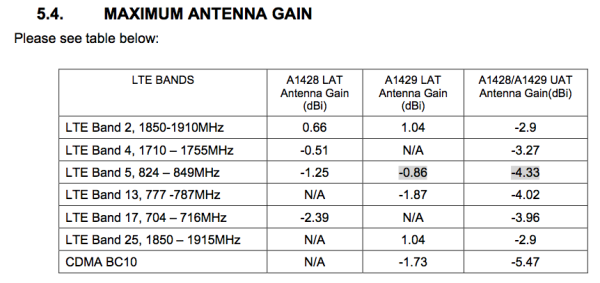
The two iPhone models have slightly different antenna gains
Apple mentioned that it actually improved this even further, and after a lot of discussions with the right people and digging, I’ve learned that the iPhone 5 actually is a 3 Rx, 1 Tx design. There are two antennas, but three Rx paths required for when the iPhone 5 is in an LTE MIMO or combining diversity mode and also required to listen to the CDMA 1x paging channel for an incoming call. This is the interesting edge case that needed to be tackled in a design without two transmit chains for CDMA and LTE networks like Verizon and Sprint.
The other repercussion is of course no simultaneous voice and data for CDMA2000 and LTE networks that aren’t running VoLTE without that second transmit chain. VoLTE is absolutely the way of the future, and Verizon has repeatedly stated their 2013 target for VoLTE. The big question is whether or not the iPhone 5 will be updated at some point to support VoLTE even though at this point it doesn’t support it. The simplest way to state things is a bit of speculation — while it’s entirely possible to update the platform to do it, there is a fair amount of overhead required (another trip through the FCC, more carrier testing, and a reworked software stack), but MDM9x15 supports it. It definitely isn’t impossible, but at the same time it’s always unwise to buy a piece of hardware with the unmade promise of some future feature being added (both Apple and Verizon won’t comment on any VoLTE updates for the iPhone 5).
The part I didn’t address in my VoLTE piece was the 2.6 GHz and TD-SCDMA China situation. This is partly speculation but I still suspect we will see at least one more hardware model surface. Already we’ve seen rumors of an A1442 for China, and clearly TD-SCDMA support has to be in the cards at some point.
The second part of the situation is transceiver. MDM9x15’s recommended configuration from what I can tell is with WTR1605, the 28nm flagship transceiver replacement for 65nm RTR8600, which is what’s inside the iPhone 5 as it exists today. So much of Apple’s component choice is driven by sheer volume, and I suspect that both design cycle and availability concerns forced Apple to use RTR8600 instead of WTR1605 which is just now starting to show up in other MSM8960 and MDM9x15 based devices. The difference is in the number of “ports” (paired up and down) supported between these two. With RTR8600 that’s 5 total, 2 below 1 GHz, 3 above 1 GHz, for a total of 5. With WTR1605 that changes to both a different RF lithography (28nm) and also adds two more ports, 3 below 1 GHz, 3 above 1 GHz, and 1 very high frequency port around 2.5 or 2.6 GHz. To support 2.6 GHz LTE this would no doubt need to be included, and I suspect the phones we’re seeing advertising 2.6 GHz LTE support today include transceiver.
Implementation and Testing
At present the iPhone 5 gracefully does the hard handover from LTE to CDMA 1x for calls, and then quickly hands back up to LTE on the Verizon handset I tested. It happens extremely quickly and I’ve yet to see it glitch out or refuse to hand back up. In addition testing verifies that there’s no simultaneous voice and data for LTE or EVDO, as expected.
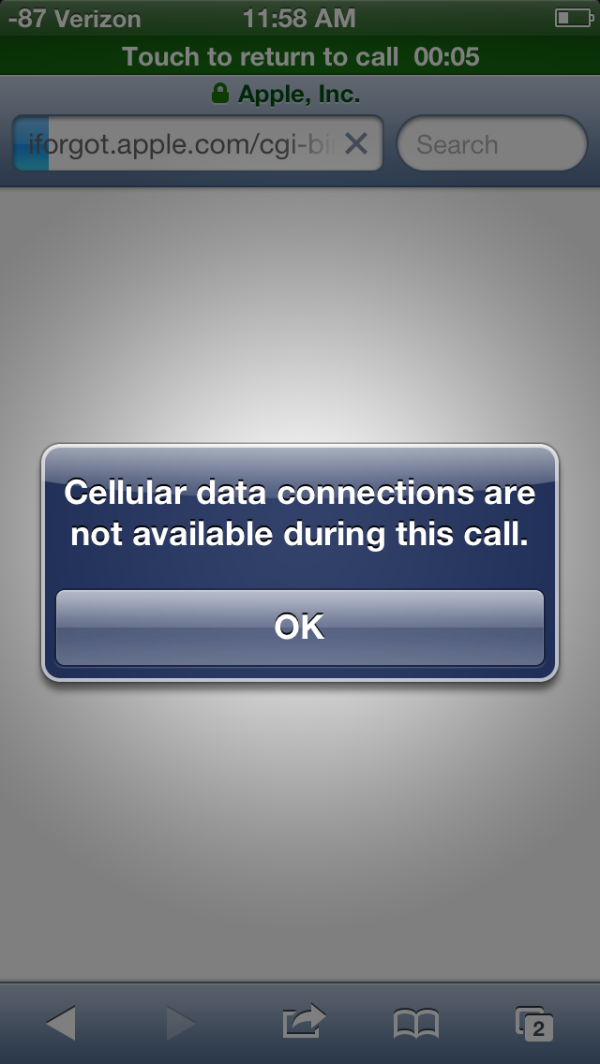
Verizon iPhone 5 showing no call and data
Outside of the errant LTE data use when connected to WiFi network glitch that was patched with the 13.1 carrier bundle, I haven’t seen any unexpected behavior on the Verizon iPhone 5.
On WCDMA/GSM and LTE carriers, the iPhone 5 implements circuit-switched fallback (CS-FB). Quite literally the phone hands down from 4G LTE to 3G WCDMA for the call (where voice and data are already multiplexed) and then back up to LTE when the call is over. In practice like all LTE handsets I’ve seen implementing CS-FB there can be a wait on the order of minutes before the handset hands back up from WCDMA to LTE depending on signal and the network. There’s nothing one can really do to expedite this process but toggle airplane mode or LTE in settings and hope for the best.
Thankfully Apple included an LTE toggle with iOS 6 on the iPhone 5, which I saw on both Verizon and AT&T. I managed to unlock my personal AT&T-provisioned iPhone 5 and see a 3G toggle with a T-Mobile SIM inserted as well and briefly tested the iPhone 5 with T-Mobile UMTS1900 in my market, which worked perfectly.
iOS 6 on iPhone 5 also includes the familiar FieldTest.app which can be accessed using the ever familiar dialer code (*3001#12345#*). Oddly enough FieldTest.app is clearly updated for the iPhone 5 but includes letterboxing. I’m overjoyed that Apple didn’t remove this like they did inexplicably with the iPhone 4. In addition to the same EVDO and UMTS engineering menus that I saw on the iPhone 4S, the iPhone 5 adds what is undeniably the best set of LTE field test informatics out there on any handset right now. Under appropriate menus are the LTE channel bandwidth, band number, RSRP, and RSRQ. RSRQ refers to the Reference Signal Received Quality (dB), and RSRP refers to Reference Signal Received Power (dBm). RSRQ ranges from –3 dB in excellent conditions to around –20 dB in poor conditions. Meanwhile RSRP will generally range from –75 dBm in excellent conditions to –120 in poor conditions. If you switch your signal indicator to numerics in FieldTest.app, that value which gets reported is RSRP, not RSSI on LTE.
Performance Testing
So the iPhone 5 includes what boils down to really the latest and greatest cellular connectivity possible at the moment, and naturally we wanted to put this to the test. To do that we turned to our usual set of tests, which consists of running lots of tests in various channel conditions using Ookla’s speedtest.net application, then batching up the data and making some pretty histograms from it. I had Anand test in his AT&T 5 MHz FDD LTE market and a few others during his travels, I tested in an AT&T 10 MHz FDD LTE market and my own AT&T market which is still just running WCDMA, and finally I borrowed a Verizon iPhone 5 and ran as many tests as I could.
Before we talk about all the results, let’s touch on the maximum achievable performance for LTE for a moment. LTE supports a variety of different channel bandwidths, and total throughput both up and down goes as a function of the total number of resource blocks available for coding data on top, which is a function of channel bandwidth. Stated another way, wider LTE channel bandwidth, more resource capacity. The limiting factor is how many resource blocks your modem can handle, and for the UE Category 3 MDM9615 that maximum translates to a maximum downlink throughput of 100 Mbps on 20 MHz channels. In the USA AT&T runs 10 MHz channels in some markets, and 5 MHz in others, for a maximum downstream throughput of 73 Mbps and 37 Mbps respectively. Verizon runs a solid 10 MHz everywhere, thus 73 Mbps down at maximum. I mentioned maximum achievable performance since these numbers include overhead already, I’ve seen some readers hitting close to these numbers already.

Note 20 MHz speeds are shown for Category 4 UEs
The iPhone 5 also supports DC-HSPA+ as I touched on earlier, although only T-Mobile is running it in the US, so there’s no way for us to test that at this point. AT&T has no plans to run DC-HSPA+ at all, and in my market only runs up to 16QAM HSDPA 14.4 Mbps down.
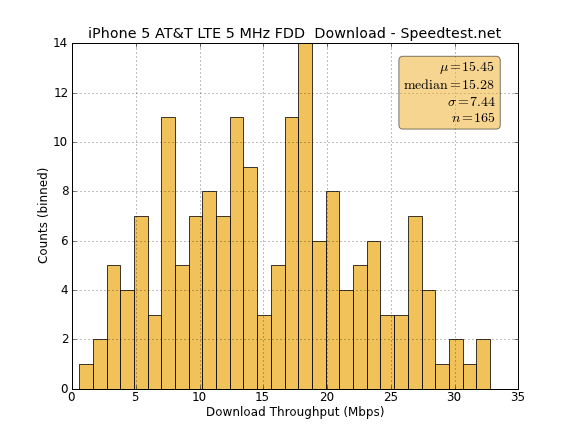
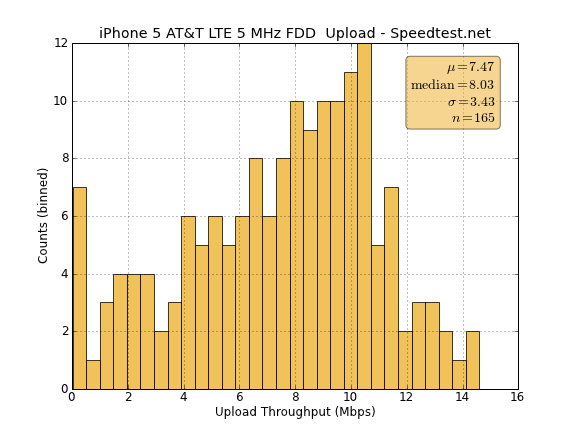
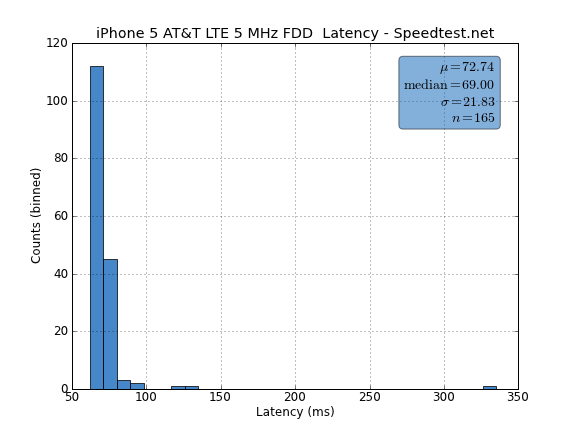
First off, Anand’s 5 MHz FDD LTE results get impressively close on the downstream to the maximum realizable throughput of 37 Mbps, at 32.77 Mbps. Upstream also comes pretty close to the maximum of 18 Mbps at 14.6 Mbps. In my 10 MHz testing in Phoenix I tried but couldn’t get as close as I would’ve liked to 73 Mbps, nevertheless an average of 18.41 Mbps is nothing to sneeze at. I’ve been very impressed with WCDMA throughput on the iPhone 5 as well, which regularly gets me results just above 12 Mbps on HSDPA 14.4 in my area, these are numbers I couldn’t see on the 4S even with my APN configured for the 4G Unlimited plan. Verizon LTE is also still speedy in my home market where I tested, though I would’ve enjoyed the opportunity to run even more data than the 66 tests I have for Verizon 4G LTE.
At present these speeds should just give an idea for LTE throughput and how much of a huge leap this is over the iPhone 4S. For CDMA subscribers on Verizon especially getting off of EVDO and onto LTE will be night and day levels of performance difference, and it’s really that changeover that will be the most dramatic.


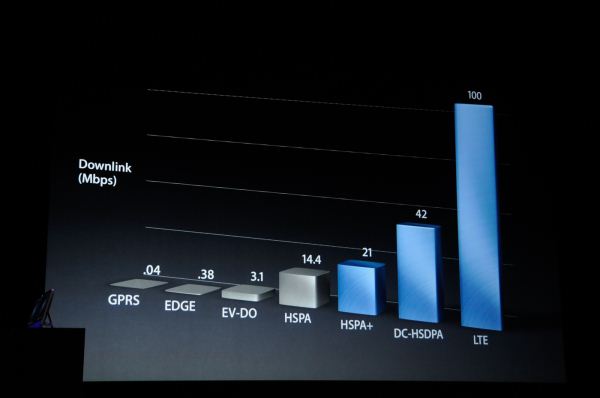
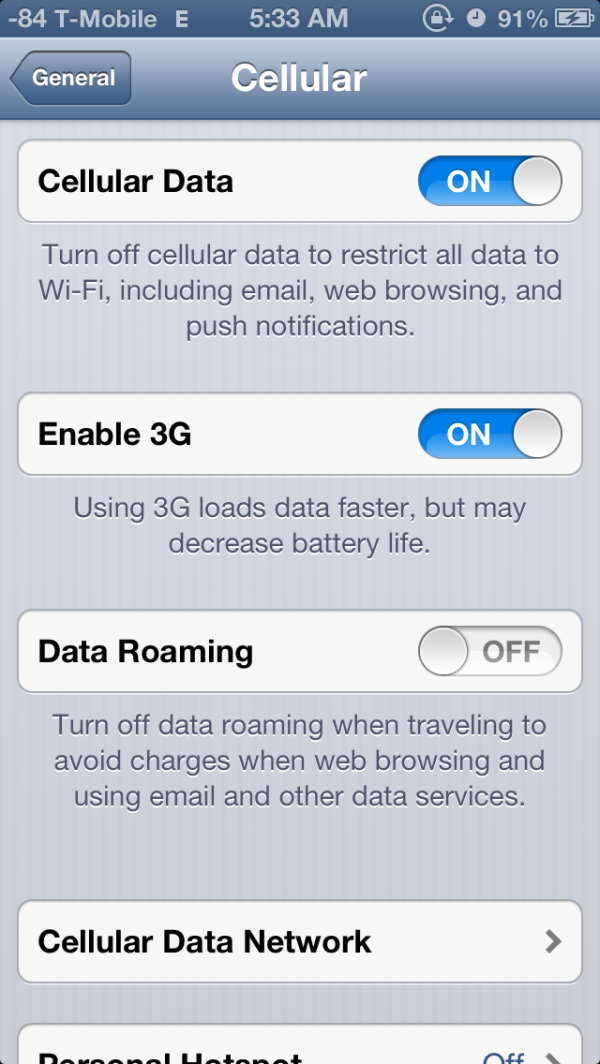
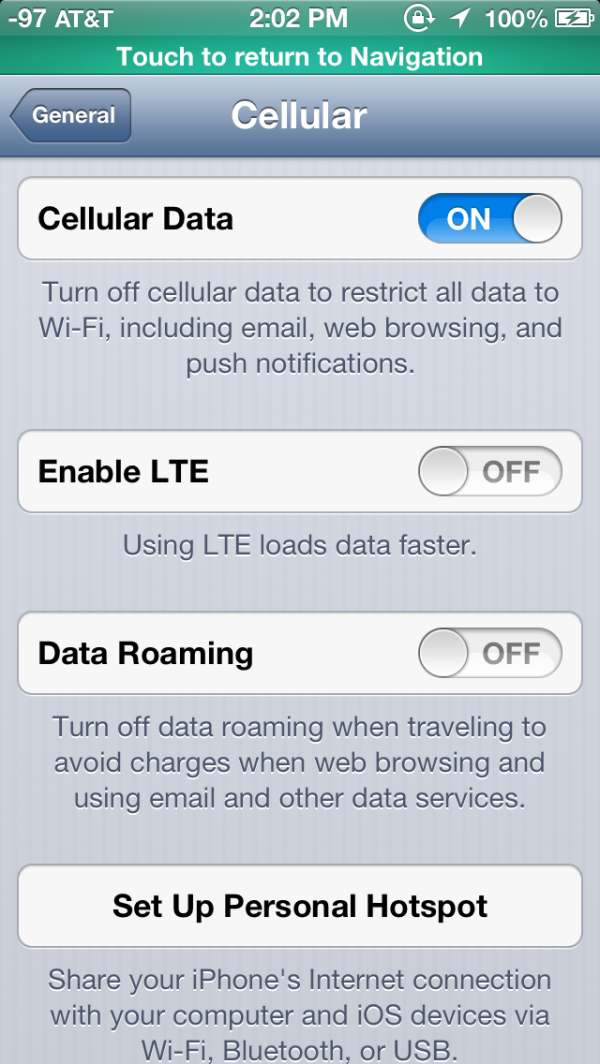
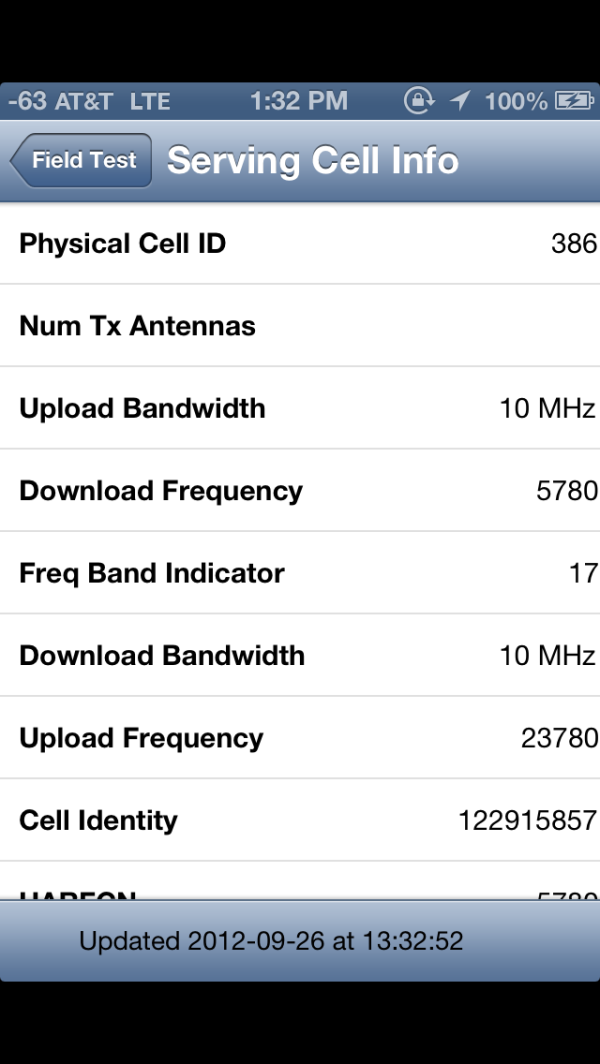















276 Comments
View All Comments
Calista - Sunday, October 21, 2012 - link
English is not my native language (as I'm sure you have noticed) and so the flow in the language is far from flawless. But I still believe my opinions are valid and that the review was too long-winded.Teknobug - Wednesday, October 17, 2012 - link
I live in a big city and I don't know a single person that went and got the iPhone 5, most are happy with the iPhone 4 or whatever phone they're using, I don't see what's so great about the iPhone 5 other than it being built better than the iPhone 4's double sided glass structure (I've seen people drop their's on the train or sidewalk and it shattering on both sides!).And what now? iPad mini? I thought Apple wasn't interested in the 6-7" tablet market, Steve Jobs said 9" is small enough. I know Apple tried a 6" tablet a decade ago but the market wasn't read for it back then.
name99 - Wednesday, October 17, 2012 - link
You know what AnandTech REALLY needs now?A comment moderation system like Ars Technica, so that low-content comments and commenters (like the above) can be suppressed.
Teknobug is a PERFECT example of Ars' Troll Type #1: "Son of the "I don't even own a TV" guy: "
This is the poster who thinks other people will find it interesting that he cares nothing about their discussion or their interests, and in fact judges himself as somehow morally superior as a result. The morphology of this on Ars Technica includes people popping into threads about Windows 8 to proclaim how they will never use Windows, people popping into threads about iOS 6 to proclaim that they never have and never will buy an Apple product, and people popping into Android related threads and claiming that they will never purchase "crappy plastic phones." In these cases, the posters have failed to understand that no one really cares what their personal disposition is on something, if they have nothing to add to the discussion.
ratte - Wednesday, October 17, 2012 - link
yeah, my thoughts exactly.worldbfree4me - Wednesday, October 17, 2012 - link
I finished reading the review a few moments ago. Kudos again for a very thorough review, however I do a have a few questions and points that I would like to ask and make.Am I wrong to say, Great Job on Apple finally catching up to the Android Pack in terms of overall performance? The GS3, HTC X debuted about 6 months ago yes?
Have these benchmark scores from the competing phones been updated to reflect the latest OS updates from GOOG such as OS 4.1.X aka Jelly Bean?
Clearly the LG Optimus G is a preview of the Nexus 4,complete with a modern GPU In Adreno 320 and 2GB ram. I think based on history, the Nexus 4 will again serve as a foundation for all future Androids to follow. But again, good Job on Apple finally catching up to Android with the caveat being, iOS only has to push its performance to a 4inch screen akin to a 1080p LCD monitor verses a true gamers 1440p LCD Home PC setup. Ciao
Zinthar - Thursday, October 18, 2012 - link
Caught up and passed, actually (if you were actually reading the review). As far as graphics are concerned, no smartphone has yet to eclipse the 4S's 543MP2 other than, of course, the iPhone 5.I have no idea what you're going on about with the Adreno 320, because that only gets graphics performance up to about the level of the PowerVR SGX 543MP2. Please see Anand's preview: http://www.anandtech.com/show/6112/qualcomms-quadc...
yottabit - Wednesday, October 17, 2012 - link
Anand, as a Mech-E, I think somewhere the anodization facts in this article got very wonkyI didn't have time to read thoroughly but I saw something about the anodized layer equaling half the material thickness? The idea of having half a millimeter anodized is way off the mark
Typically there are two types of anodizing I use: regular, and "hard coat anodize" which is much more expensive
If the iPhone is scuffing then it's definitely using regular anodizing, and the thickness of that layer is likely much less than .001" or one thousandth of an inch. More on the order of a ten-thousandth of an inch, actually. The thickness of traditional anodizing is so negligible that in fact most engineers don't even need to compensate for it when designing parts.
Hard-coat anodize is a much more expensive process and can only result in a few darker colors, whereas normal anodizing has a pretty wide spectrum. Hard-coat thicknesses can be substantial, in the range of .001" to .003". This usually must be compensated for in the design process. Hard coat anodize results in a much flatter looking finish than typical anodize, and is also pretty much immune to scratches of any sort.
Aluminum oxide is actually a ceramic which is harder than steel. So having a sufficient thickness of anodize can pretty much guarantee it won't be scratched under normal operating conditions. However it's much cheaper and allows more colors to do a "regular" anodize
When I heard about scuffgate I immediately thought one solution would be to have a hardcoat anodize, but it would probably be cost prohibitive, and would alter the appearance significantly
guy007 - Wednesday, October 17, 2012 - link
A little late to the party with the review, the iPhone 6 is almost out now...jameskatt - Wednesday, October 17, 2012 - link
Anand is pessimistic about Apple's ability to keep creating its own CPUs every year. But realize that the top two smartphone manufacturers (Apple and Samsung) are CRUSHING the competition. And BOTH create their own CPUs.Apple has ALWAYS created custom chips for its computers - except for a few years when Steve Jobs accidentally let their chip engineers go when they switched to Intel and Intel's motherboard designs.
Apple SAVES a lot of money by designing its own chips because it doesn't have to pay the 3rd party profit on each chip.
Apple PREVENTS Samsung from spying on its chip designs and giving the data to its own chip division to add to its own designs. This is a HUGE win given Samsung's copycat mentality.
Apple can now always be a step ahead of the competition by designing its own chips. Realize that others will create copies of the ARM A15. But only Apple can greatly improve on the design. Apple, for example, greatly improved the memory subsystem on its own ARM chips. This is a huge weakness on otherARM chips. Apple can now custom design the power control as well - prolonging battery life even more. Etc. etc.
phillyry - Sunday, October 21, 2012 - link
Good points re: copycat and profit margin savings.I've always been baffled by the fact that Apple outsources their part manufacturing to the competition. I know that Samsung is a huge OEM player but they are stealing Apple's ideas. They are doing a very good job of it and now improving on those ideas and techs, which is good for the consumer but still seems completely illogical to me from Apple's perspective. Must be the 20/20 hindsight kicking in again.